Effect of external electric field on the terahertz transmission characteristics of electrolyte solutions*
Jia-Hui Wang(王佳慧) Guo-Yang Wang(王國陽) Xin Liu(劉欣) Si-Yu Shao(邵思雨)Hai-Yun Huang(黃海云) Chen-Xin Ding(丁晨鑫) Bo Su(蘇波) and Cun-Lin Zhang(張存林)
1Beijing Advanced Innovation Centre for Imaging Theory and Technology,Beijing 100048,China
2Beijing Key Laboratory for Terahertz Spectroscopy and Imaging,Beijing 100048,China
3Key Laboratory of Terahertz Optoelectronics,Ministry of Education,Beijing 100048,China
4Department of Physics,Capital Normal University,Beijing 100048,China
Keywords: terahertz,microfluidic chip,electrolyte solution,electric field,transmission intensity
1. Introduction
Terahertz (THz) radiation refers to the electromagnetic radiation in the frequency that ranges from 0.1 to 10 THz,with a corresponding wavelength that ranges from~30 to 3000 μm. It lies between the microwave and infrared wavelengths in the electromagnetic spectrum.[1-4]The frequency of rotation,vibration of numerous biological macromolecules or vibration of the entire molecular groups (such as hydrogen bonds and van der Waals forces) is located in the THz band, such that it can interact with THz radiation. This provides the basis for characterising the internal structure of biological molecules using THz technology[5]Hence, the THz wave plays a crucial role in detecting biological molecules.Simultaneously, owing to the low photon energy of the THz wave,[6]which is only of the order of meV,it does not damage biomolecules in the detection process,such that THz time domain spectroscopy technology has a good application prospect in biological detection.For some biomolecules,the solid powder can be pressed to measure the THz band fingerprint spectrum to achieve molecular detection. Yanget al.[7]used transmission and reflection THz time domain spectroscopy to detect melatonin solids with different mass ratios after compression and found that the absorption peaks were basically consistent with those obtained by density functional theory.
Most biomolecules maintain their biological activity only in aqueous solution. Thus, characterising the dynamic characteristics of the interaction between biomolecules in aqueous solution is important.Aoki[8]and colleagues studied the effect of ammonium sulphate on the hydration kinetics of lysozyme using THz time domain spectroscopy. The results show that ammonium sulphate increases the absorption coefficient of hydrated water. With the increase of ammonium sulphate concentration, the kinetics of hydrated water becomes faster and the molecular number of hydrated water decreases. This is because the rotation mode, vibration mode and energy related to the hydrogen bond of water molecules are in the THz band, which yields strong absorption characteristics of water to THz wave.[9-11]Due to the noncoincidence of positive and negative charges, water molecules are polarized and exhibit strong resonance absorption to terahertz wave.[12]Moreover,all kinds of sugar molecules in solution,such as glucose molecules in animal cells and sucrose molecules in plant cells,combine with free water to form hydrogen bonds,which limits the polarisation and free diffusion of water molecules in solution. However, combined water forms strong hydrogen bonds with polar groups of carbohydrate, protein, starch, fibre,alcohol and other components in tissues,making it unable to freely move. Therefore, studying the dynamic characteristics of biomolecules in liquid environment by THz technology is difficult. Hence,in the study of the interaction between biomolecules and THz waves,the influence of hydrogen bonds in water must be minimised or avoided. Panet al.[13]studied the influence of different kinds of ions on the structure of water and found that the hydrogen bond stretching and energy transfer in other modes are promoted due to the affinity effect of cations on water, thus inhibiting the originally dominant hydrogen bond bending motion. Because of the change of the molecular structure of water,the THz transmission characteristics accordingly change. Wenet al.[14]tested the THz transmission intensity of 17 electrolyte solutions. The effect of different electrolytes on the hydrogen bond between water molecules was analysed by observing the spectral intensity changes in the range of 0.1-1.0 THz. Furthermore, the microfluidic chip likewise has the characteristics of simple fabrication and high detection efficiency,which has a wide application prospect in the field of biochemical analysis.In this study,THz and microfluidic chip technology are combined to study the influence of deionised water and common electrolyte solution after electric field treatment on the transmission characteristics of THz wave, which opens a novel approach to further understand the microstructure of molecules in aqueous solution.
2. Experimental system
2.1. Experimental device and optical system
The THz time domain spectroscopy system used in the experiment includes a femtosecond laser, THz radiation generation device, time delay device and THz radiation detection device. The laser is a self-mode locked fibre femtosecond laser, independently developed by Peking University. Its central wavelength is 1550 nm, with a pulse width of 75 fs,pulse power of 130 mW and pulse repetition rate of 100 MHz.The photoconductive antenna used to generate the THz wave is bpca-100-05-10-1550-c-f produced by BATOP,the photoconductive antenna for THz wave detection is bpca-180-05-10-1550-c-f and the time delay device is the electric translation platform produced by Daheng Optoelectronics Co.,Ltd.
The optical path employed in the experiment is shown in Fig. 1. The femtosecond pulse laser output by the fibre femtosecond laser is split into two beams after passing through the polarising beam splitter. One of these beams is used as the pump pulse; after passing through the mechanical translation platform, it enters the fibre photoconductive antenna through the fibre coupler to generate THz wave. The other beam is employed as the detection pulse; it extends the optical path through the reflector to equal the optical paths of the detection and the pumping. It enters the fibre-optic photoconductive antenna through the fibre coupler to detect the THz wave. The microfluidic chip filled with the sample is placed in the electric field for different durations of time. Subsequently,it is placed in the middle of two off-axis polishing mirrors, i.e., the focal position of the THz spot. The THz wave, generated by the THz transmitting antenna, will carry the sample information processed by the electric field after passing through the chip;subsequently,it will be received by the detecting antenna and input into the lock-in amplifier for amplification. Finally, the data will be collected and processed by the computer.

Fig. 1. Experimental light path (M1-M5, reflector; PBS, polarisation beam splitter;λ/2,1/2 wave plate;OAP,off-axis parabolic mirror).
2.2. Fabrication of microfluidic chip
The microfluidic chip used in the experiment is a sandwich microfluidic chip,as shown in Fig.2. The substrate and cover of the microfluidic chip are made of cycloolefin copolymer, which has a THz transmittance above 95%. The size of the substrate and cover is 35×35×2 mm3. Two round holes with a radius of 1 mm are carved on the cover according to the position of the die. The window material is cleaned with alcohol in ultrasonic cleaning machine. We take a piece of doublesided adhesive with a thickness of 50 μm, carve a groove on the mould,place it on the substrate and cover it with the cover.Afterwards, we compact and seal it with hot melt adhesive around the chip and at the joint of the inlet and outlet. Finally,the influence of microfluidic chips with channel thicknesses of 50,100,150,and 200μm on the THz transmission intensity of deionised water is tested,as shown in Fig.3. The THz transmission intensity of the sample significantly decreases with the increase in the chip thickness. Considering the experimental conditions, the microfluidic chip with 100-μm channel thickness is selected for the experiment.

Fig.2. Schematic of microfluidic chip bonding.
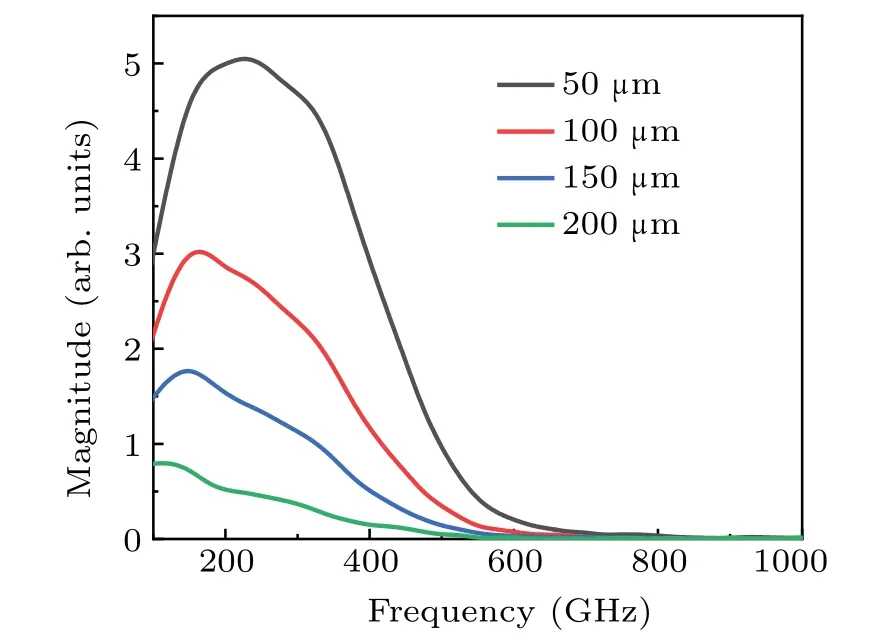
Fig. 3. THz transmission intensity of microfluidic chips with different thicknesses.
2.3. External electric field device
The schematic diagram of the external electric field experimental device used in this experiment is shown in Fig.4,which is composed of a power supply, a zero voltage switching circuit packaged in a plexiglass box and a DC high voltage package with an output voltage of 10000 V. One end of the zero voltage switching(ZVS)circuit is connected with switching power supply,the other end is connected with high voltage package, and the output end of high voltage package is connected with two metal plates by wires. To ensure that the electric field of the microfluidic chip is uniform,the size of the two metal plates is significantly larger than that of the microfluidic chip, and the chip is placed in the middle of the two metal plates. The distance between the two metal plates is 4 cm,and the electric field intensity is 2500 V/cm.
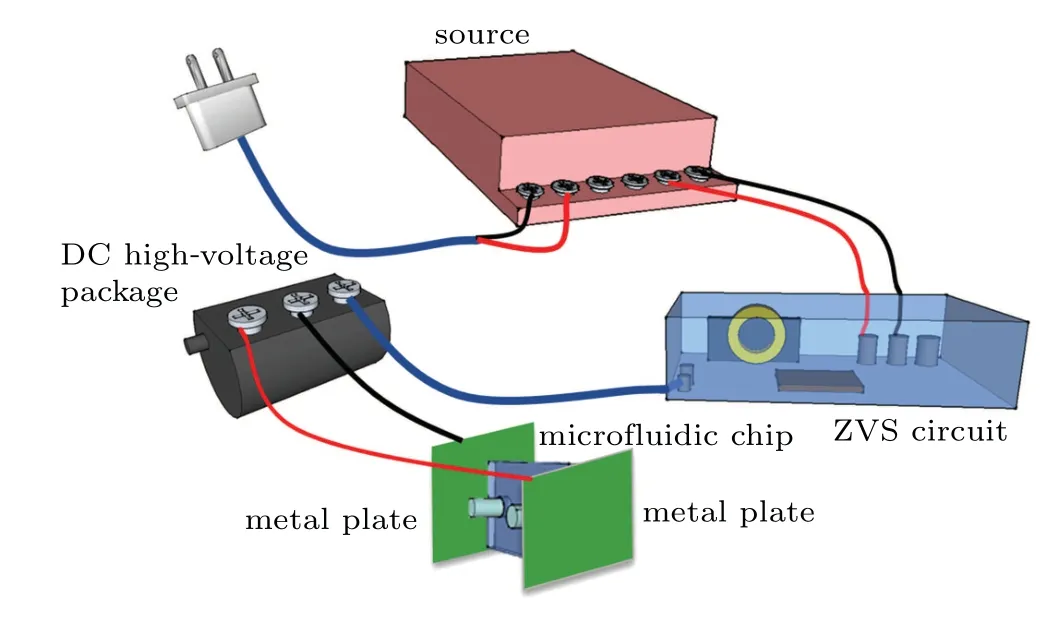
Fig.4. Schematic of the external electric field test device.
3. Experiments and results
To avoid the influence of ionic impurities in aqueous solution,deionised water was used to prepare the solution. Firstly,0.6 mol/L CuSO4, CuCl2, NaHCO3and Na2CO3electrolyte solutions were prepared and sequentially injected into the microfluidic chip. They were then put into the external electric field device and left for 0(without electric field treatment),5,10, 15 and 20 min, respectively. Finally, the transmission intensity was measured by the THz time domain spectroscopy(THz-TDS)system.
3.1. Effect of external electric field on THz transmission characteristics of deionized water
A disposable syringe is used to inject deionised water into the microfluidic chip,after which the microfluidic chip is placed in the electric field. The THz transmission intensity of the deionised water placed in the electric field for 0,5,10,15,and 20 min is measured by the THz-TDS system,and the obtained spectrum is shown in Fig.5. The transmission intensity of deionised water treated by external electric field is larger than that of untreated deionised water,and the THz transmission intensity gradually increases with the increase of treatment time. The THz transmission characteristics of 15 and 20 min almost coincide,indicating that the transmission intensity of THz reaches the maximum when the external electric field time reaches approximately 15 min.
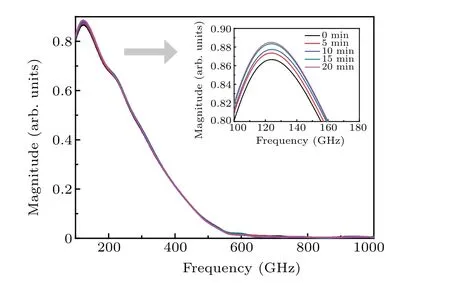
Fig.5. THz transmission intensity spectra of deionised water after different durations of electric field treatment.
3.2. Effect of external electric field on THz transmission properties of CuSO4 and CuCl2 solutions
The prepared solutions of 0.6 mol/L CuSO4and CuCl2were injected into two identical microfluidic chips and then placed under the electric field for standing treatment. The standing time of electric field treatment was 0, 5, 10, 15, and 20 min, respectively. Subsequently, the microfluidic chip is tested by THz-TDS system to obtain the time domain spectrum, and then the frequency domain spectrum is obtained by Fourier transform, as shown in Figs. 6 and 7. The THz transmission intensity of CuSO4solution treated by an electric field increased in the following order of treatment duration: 20>15>10>5>0 min; the THz transmission intensity of the CuCl2solution increased with the increase of the applied electric field time;however,the THz transmission spectra of the CuCl2solution after standing for 15 and 20 min almost coincide, indicating that the THz transmission intensity has reached the maximum when the applied electric field treatment duration reaches about 15 min. For the treatment duration of 15 min,the polarisation direction in the electrolyte solution tended to saturate and the degree of damage of the hydrogen bonds in the electrolyte solution was the maximum due to the applied electric field, which no longer affected the THz transmission characteristics.

Fig.6. THz transmission intensity spectra of CuSO4 solution with different duration of electric field treatment.
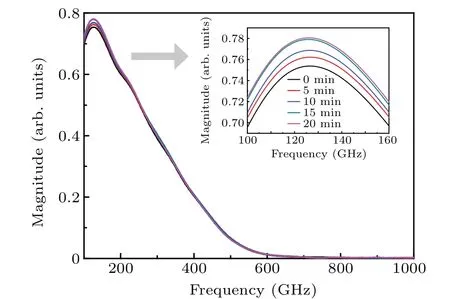
Fig.7. THz transmission intensity spectra of CuCl2 solution with different duration of electric field treatment.
3.3. Effect of external electric field on THz transmission properties of NaHCO3,Na2CO3 and NaCl solutions
The frequency domain spectra of 0.6 mol/L of NaHCO3,Na2CO3and NaCl solutions standing in the electric field for different durations of time are obtained, as shown in Figs.8-10. The relationship between THz transmission intensity and standing time in electric field increases with the treatment duration in the following order: 20>15>10>5>0 min.
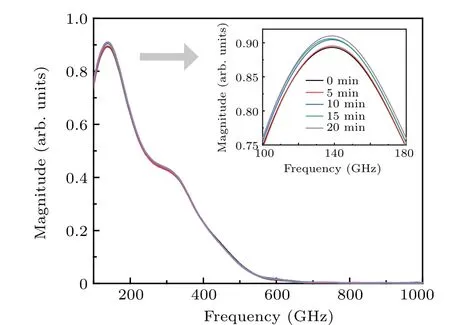
Fig. 8. THz transmission intensity spectra of NaHCO3 solution with different duration of electric field treatment.
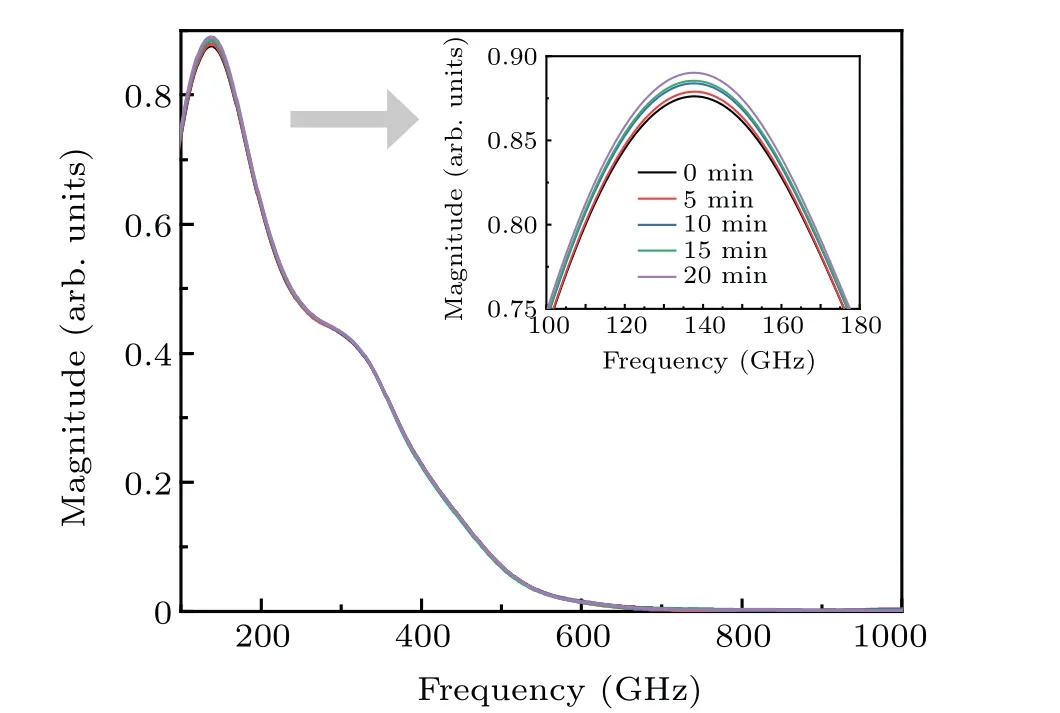
Fig. 9. THz transmission intensity spectra of Na2CO3 solution with different duration of electric field treatment.

Fig.10. THz transmission intensity spectra of NaCl solution with different duration of electric field treatment.
3.4. Discussion
Water is the source of life in nature.As a versatile solvent,it plays a crucial role in numerous fields,including chemistry and biomedicine. The research on the dynamic structure of water molecules has been the constant focus of researchers in various fields. To a large extent, the unique properties of water are due to its ability to form complex hydrogen bond networks. The water molecule exhibits strong polarity. Owing to intermolecular hydrogen bonding, it can form water structures of different clusters, such as independent free water molecules and water molecules with one to five unequal hydrogen bonds.[15]However, due to the changes in the external environment (temperature, pressure, and the dissolved matter in water), the number and strength of hydrogen bonds in the solution are constantly changing. For example, when the temperature is high, the hydrogen bonds between water molecules are broken,or when some electrolyte molecules are added to water,the hydrogen bonds between water molecules are likewise affected.
By changing the duration of the applied electric field,the effect of the applied electric field on the terahertz transmission characteristics of several electrolyte solutions was studied. The change of THz transmission peak with time of deionized water and CuSO4, CuCl2, NaHCO3, Na2CO3, NaCl solutions is shown in Fig. 11. It can be found that the THz transmission peak increases with the increase of applied electric field time. The results show that the applied electric field changes the structure of water molecules and reduces the terahertz absorption.
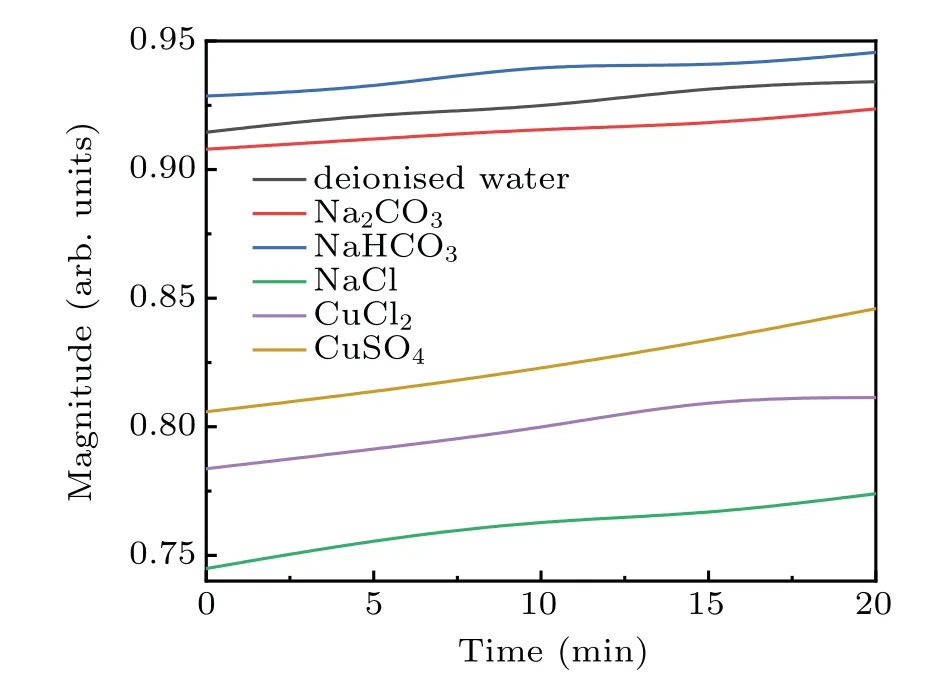
Fig.11. Dependence of terahertz peaks value on time in different solutions.
The strong absorption of the THz wave by water is primarily due to the resonance absorption of hydrogen bonds around water molecules.At present,the research of THz radiation in biomedicine is mainly limited by the strong absorption of THz wave by water. Hydrodynamics is essentially determined by the interaction between local hydrogen bonds and surrounding water molecules.[16]The orientation of the solvent molecules is reoriented under external electric field, and the degree of orientation reaches saturation with increase in electric field strength, resulting in the decrease of dielectric constant of the solution. The peak value of O-H radial distribution function in electrolyte solution is changed by the applied electric field. Compared with that without the applied electric field, the peak value of O-H radial distribution function slightly decreases. This indicates that the applied electric field can weaken the effect of the hydrogen and other bonds in the solution,resulting in the increase of the number and activity of single water molecule and the increase in the diffusion coefficient of water molecule, which hinders ion bonding in the solution.[17]Therefore, under the action of external electric field,the THz transmission intensity of electrolyte solution increases with the increase of its time in the electric field,indicating that the absorption of electrolyte solution to THz wave decreases,which provides a new method for improving the detection sensitivity of THz in electrolyte solution.
The advantage of terahertz technology combined with microfluidic technology in analyzing liquid samples is that the dynamic characteristics of molecules can be obtained from a small number of samples. However,from the research results of several electrolyte solutions, the change of THz signal is very weak. In order to further reflect the advantages of the combination of these two technologies,we plan to improve the signal response by adopting high power femtosecond laser,increasing bias voltage of photoconductive antenna and improving the amplification performance of signal amplifier circuit in the next research.
4. Conclusions
In summary, we use the self-made microfluidic chip and the self-built THzTDS system to study the terahertz transmission characteristics of water and electrolyte solution standing in the electric field for different times. The results show that with the increase of the standing time, the transmission intensity of THz wave increases and finally reaches saturation,but for different electrolytes, the time to reach saturation is different. It shows that the external electric field will affect the hydrogen bond in the solution. The experimental results are consistent with the theoretical analysis,which provides the technical support for the study of molecular dynamics in the microcosmic field.
- Chinese Physics B的其它文章
- Numerical investigation on threading dislocation bending with InAs/GaAs quantum dots*
- Connes distance of 2D harmonic oscillators in quantum phase space*
- Classical-field description of Bose-Einstein condensation of parallel light in a nonlinear optical cavity*
- Dense coding capacity in correlated noisy channels with weak measurement*
- Probability density and oscillating period of magnetopolaron in parabolic quantum dot in the presence of Rashba effect and temperature*
- Hardware for multi-superconducting qubit control and readout*

